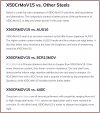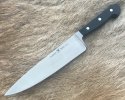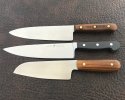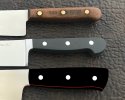The knife itself is an A J Henckels International 8" chef knife, it would be there entry level knife, Made in Spain, for a serious home chef or restaurant chef, that retail for about $50.00 to $60.00 So I don't think I did too bad on it, not mention I've always liked Henckels knives. The little checker board near the handle from my understanding signifies the date it was made, however, I was unable to verify this. The steel is X50CrMoV15. Here is alloy make up of the steel.

I looks similar to AEB-L but with a little less carbon and a little more chrome and also with the addition of some vanadium. At first glance I would think the performance would be on par with AEB-L but I think that will most likely come down to heat treating. I did find a bit of information on heat treating that kind of confirmed what I was thinking when I honed the knife on some stone. I would glass this knife would be closer to HRC-56.
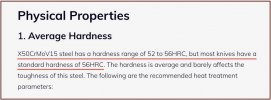
When I first brought the knife to my shop and cleaned it up I decide to play with it a bit on my India stones to get rid of the ratty edge and get a feel for the steel, the first thing I noticed was with the first stroke the stone grabbed the steel and started aggressively cutting, like a steel that's a bit on the softer side, so after a few passes I hit the edge on my buffing wheel with green chrome rouge and it got good and sharp, I put the final edge on with steel, and it got screaming sharp.
The actual specs of the knife are 8 1/8" from where the edge begins, 1 7/8" wide, and 0.150" thick with a distal taper a ll the way out to the tip, with the edge being 0.020" thick as well. The knife drop forged with an integral guard and the tang is 1/8" thick, with 2 plastic scales and 3 aluminum rivets being the remainder of the handle.
This makes for a heavy knife at 9.5 ounces.
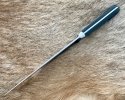
All in all this knife is build like a tank, designed to last a life time and then some for certain, this and the looks are 2 of the things I really like about this knife. Things I don't like about the knife are the weight, and the squarish handle, but I do like the birds beak at the butt of the handle. The more I use the knife the more I'm ok with the squarish handle, I wish the handle was a bit deeper, it's 5/8" thick, 7/8" at the deepest point, and 5/8" at the top and bottom of the handle, I would like the feel better if the handle were a full 1/4" deeper, I'm ok with the handle thickness.
I don't know much about this steel, but I going to give it a really good workout in my kitchen for a while and see how it compares to my Santoku with AEB-L heat treated with cryo to HRc-62, just to see how the 2 compare to each other. The Santoku weighs in at 7 ounces and has a 6 1/2" blade made from 0.100" AEB-L ground to 0.010" at the edge.
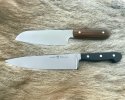
The Santoku handle is about 1 1/4" deep and perfectly oval shaped that fills my hand nicely, I wish I would have made the blade 8" long instead of 6 1/2" I think it would have made the knife more versatile.
Bottom line here is I would like to get a good side by side comparison of the 2 knives. 1.) First of all, to see how the 2 steels compare, which I think I have a pretty good idea already, 2.) Second of all, to see what I like about the new knife to see if I will be changing anything on future knives I make.
Anyhow here is small bit of information on steel comparisons of how X50CrMoV15 stacks up against some other steels.
